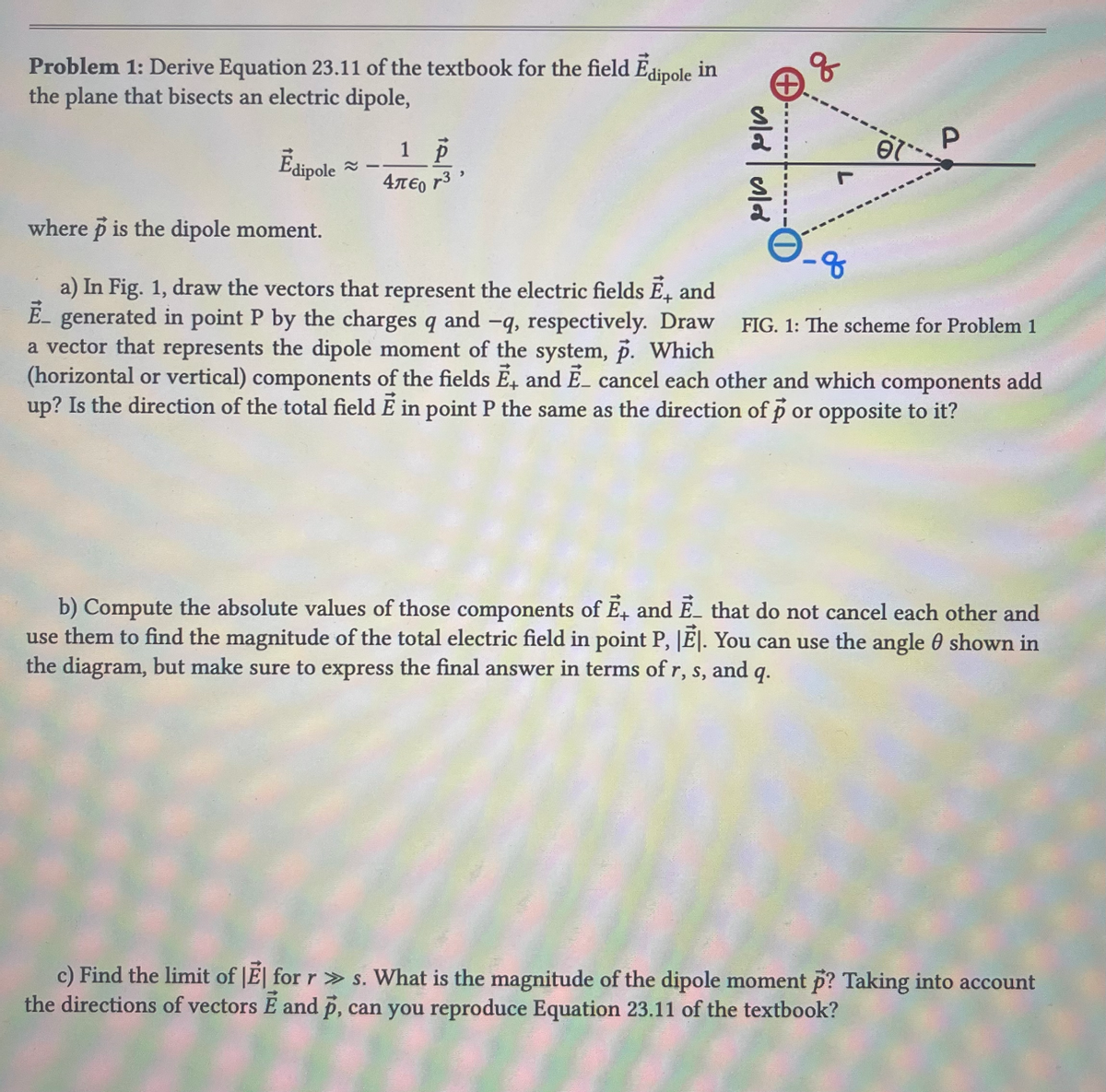Problem 1: Derive Equation 23.11 of the textbook for the field Edipole in the plane that bisects an electric dipole, Edipole 1 p 4περ 13 3 where p is the dipole moment. a) In Fig. 1, draw the vectors that represent the electric fields E. and
Problem 1: Derive Equation 23.11 of the textbook for the field Edipole in the plane that bisects an electric dipole, Edipole 1 p 4περ 13 3 where p is the dipole moment. a) In Fig. 1, draw the vectors that represent the electric fields E. and
Principles of Physics: A Calculus-Based Text
5th Edition
ISBN:9781133104261
Author:Raymond A. Serway, John W. Jewett
Publisher:Raymond A. Serway, John W. Jewett
Chapter19: Electric Forces And Electric Fields
Section: Chapter Questions
Problem 18P
Related questions
Question
I need help with a,b, and c. My professor won't help me and I am helping problem will this problem. Can you label which one is A, B and C, thank you so much

Transcribed Image Text:Problem 1: Derive Equation 23.11 of the textbook for the field Edipole in
the plane that bisects an electric dipole,
Ēdipole
1 p
4πε 13
ને ર
q
el
P
where p is the dipole moment.
-8
FIG. 1: The scheme for Problem 1
a) In Fig. 1, draw the vectors that represent the electric fields Ē, and
E-generated in point P by the charges q and -q, respectively. Draw
a vector that represents the dipole moment of the system, p. Which
(horizontal or vertical) components of the fields Ē, and E_ cancel each other and which components add
up? Is the direction of the total field E in point P the same as the direction of p or opposite to it?
b) Compute the absolute values of those components of E, and E_ that do not cancel each other and
use them to find the magnitude of the total electric field in point P, |E|. You can use the angle shown in
the diagram, but make sure to express the final answer in terms of r, s, and q.
c) Find the limit of El for r»s. What is the magnitude of the dipole moment p? Taking into account
the directions of vectors E and p, can you reproduce Equation 23.11 of the textbook?
Expert Solution
This question has been solved!
Explore an expertly crafted, step-by-step solution for a thorough understanding of key concepts.
This is a popular solution!
Trending now
This is a popular solution!
Step by step
Solved in 2 steps with 3 images

Knowledge Booster
Learn more about
Need a deep-dive on the concept behind this application? Look no further. Learn more about this topic, physics and related others by exploring similar questions and additional content below.Recommended textbooks for you

Principles of Physics: A Calculus-Based Text
Physics
ISBN:
9781133104261
Author:
Raymond A. Serway, John W. Jewett
Publisher:
Cengage Learning

Physics for Scientists and Engineers: Foundations…
Physics
ISBN:
9781133939146
Author:
Katz, Debora M.
Publisher:
Cengage Learning

College Physics
Physics
ISBN:
9781285737027
Author:
Raymond A. Serway, Chris Vuille
Publisher:
Cengage Learning

Principles of Physics: A Calculus-Based Text
Physics
ISBN:
9781133104261
Author:
Raymond A. Serway, John W. Jewett
Publisher:
Cengage Learning

Physics for Scientists and Engineers: Foundations…
Physics
ISBN:
9781133939146
Author:
Katz, Debora M.
Publisher:
Cengage Learning

College Physics
Physics
ISBN:
9781285737027
Author:
Raymond A. Serway, Chris Vuille
Publisher:
Cengage Learning

Physics for Scientists and Engineers, Technology …
Physics
ISBN:
9781305116399
Author:
Raymond A. Serway, John W. Jewett
Publisher:
Cengage Learning
